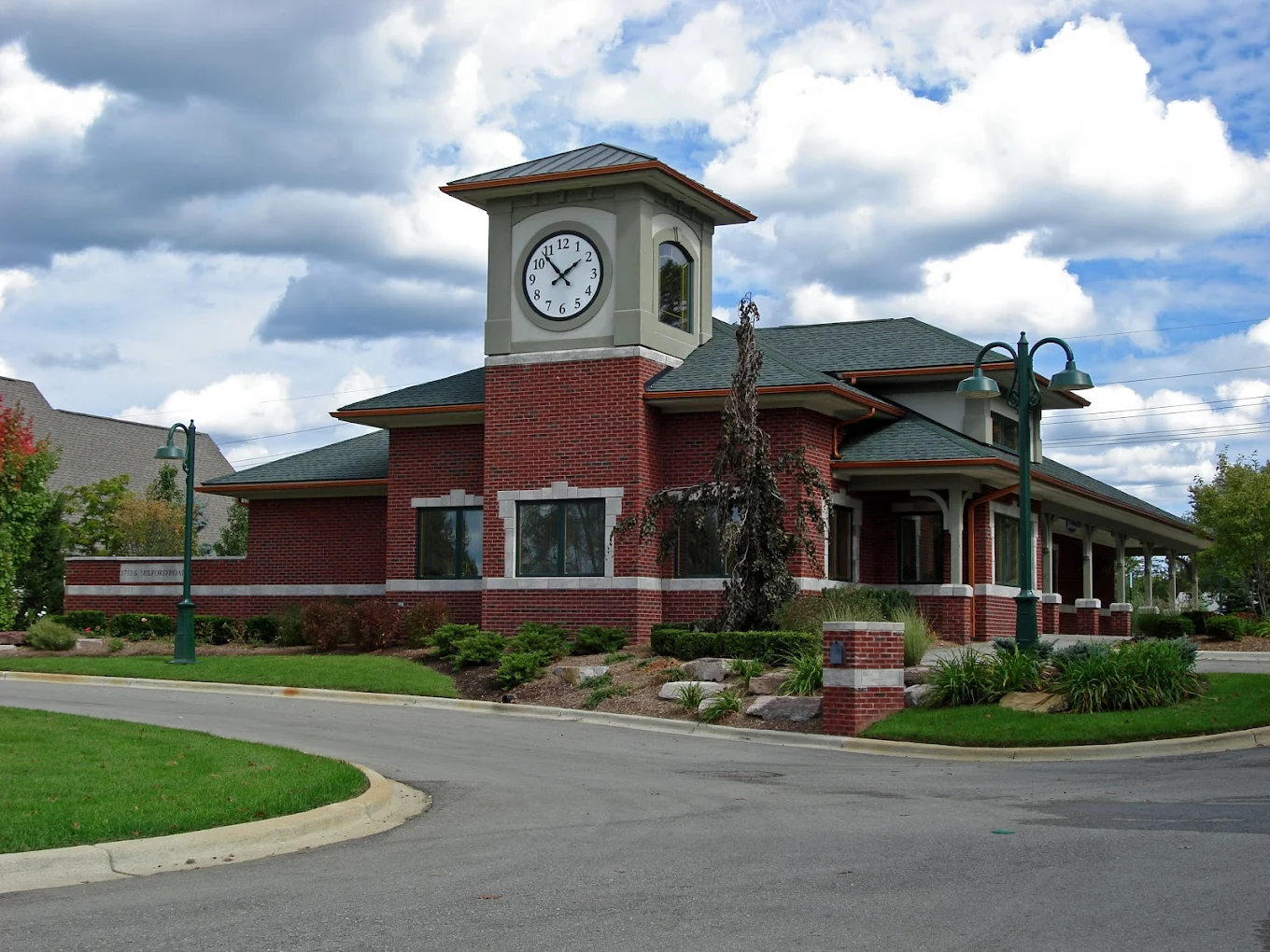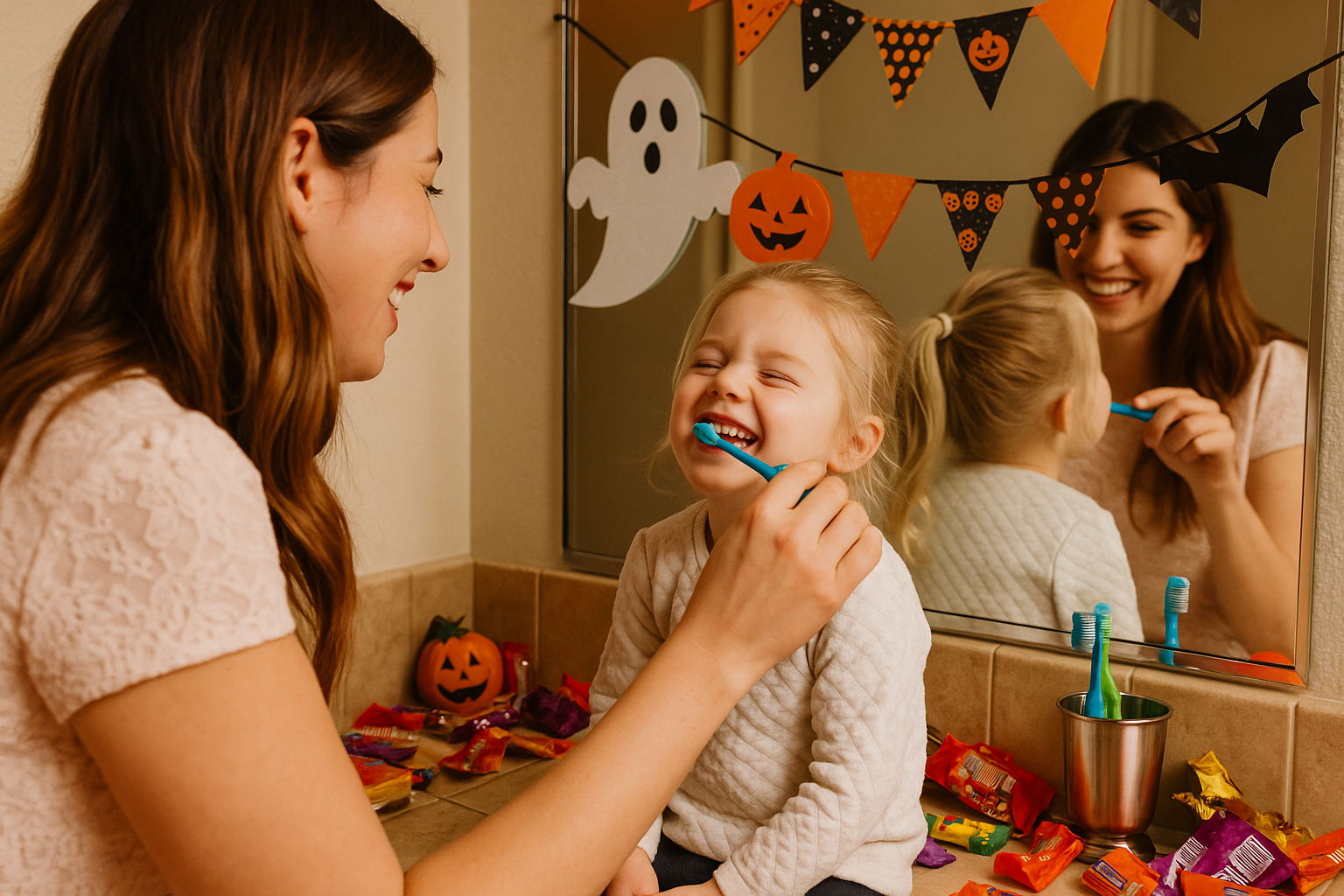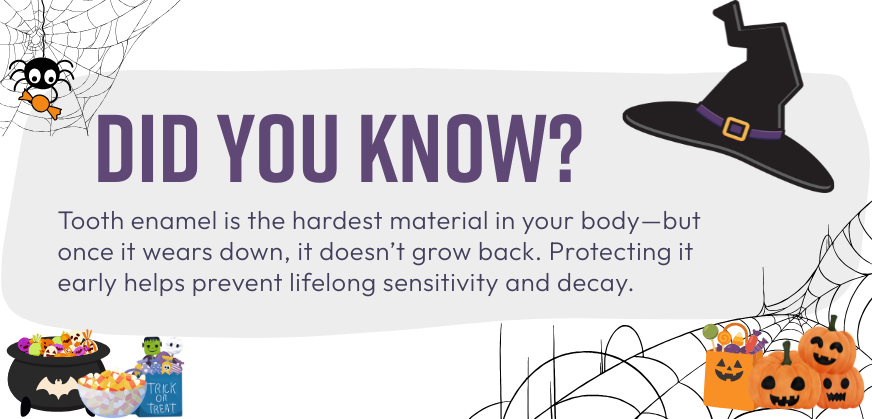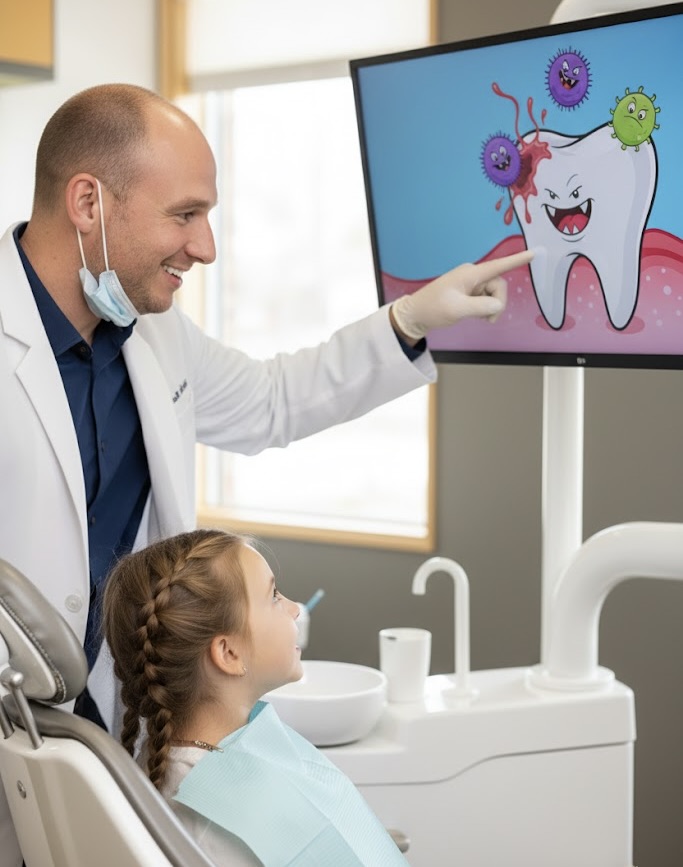
Expert dental tips, news, and smile advice

Expert dental tips, news, and smile advice

Megan loved Halloween. Every year, she turned her Highland driveway into a mini haunted house—fog machine, spooky music, the works. Her kids, Lucy and Ben, would sprint from house to house, their orange buckets filling faster than Megan could hand out candy to the neighborhood kids.
When they got home, the sorting ritual began. The kids spread their loot across the living room carpet like little candy merchants—one pile for chocolate, one for gummies, one for “Mom’s tax.” Megan didn’t think much of it. “It’s just once a year,” she told herself. “They’ll brush tonight. They’ll be fine.”
But by the second week of November, Lucy was chewing carefully on one side of her mouth. “It just hurts when I bite something crunchy,” she whispered one morning over breakfast. Megan figured it was a seed, maybe a loose baby tooth. It wasn’t—by the time they came in for an appointment, a small cavity had formed deep enough to need a filling.
“I thought I was being careful,” Megan told Dr. Fortson later. “We brushed every night. I didn’t realize timing mattered more than total sugar.”
When most parents think of cavities, they picture kids who don’t brush. But even families who are diligent about brushing can run into trouble—especially during candy-heavy seasons like Halloween.
Dr. Fortson explained it like this:
“It’s not how much candy your child eats—it’s how long the sugar stays on their teeth. Every time they eat something sweet, bacteria in the mouth feed on that sugar and create acid. That acid softens enamel for about 20 minutes. So, if your child grazes on candy all afternoon, their teeth are under acid attack for hours.”
Sticky candies like caramels, gummies, and taffy are the worst offenders because they cling to the chewing surfaces of molars and slip between teeth where brushes can’t reach. Sour candies double the damage—they bring both sugar and acid, eroding enamel even faster.
Even chocolate, the “safe” candy, can cause issues if eaten too frequently without rinsing or brushing. “The problem isn’t the treat itself,” said Dr. Fortson. “It’s how long the mouth stays acidic.”

In the week after Halloween, many families see an uptick in dental sensitivity and early signs of decay. It’s not just kids, either—parents sneak candy, too.
The hidden danger is frequency. A few mini chocolate bars after dinner? No problem. But grazing every hour keeps acid levels high all day. That acid weakens enamel, making it easier for bacteria to settle in and cause decay.
The irony? Parents often try to spread candy out over several days “to make it last,” but that actually makes the dental risk worse.
When Megan learned this, it clicked. “I was trying to be responsible,” she said, laughing. “I thought I was avoiding a sugar overload. I didn’t realize I was creating a sugar marathon.”
After Lucy’s cavity was treated, Megan sat with Dr. Fortson and the hygienist to come up with a realistic plan—something that didn’t feel like punishment for Halloween fun.
They agreed on a new rule: candy time would happen right after dinner. That way, saliva production was already high from the meal (which helps neutralize acid), and Lucy could brush right afterward. No more all-day grazing, and no candy in lunchboxes.

“It made such a difference,” Megan said at Lucy’s next cleaning. “It turned candy from something she snuck into something we enjoyed together—then brushed away.”
Dr. Fortson nodded. “That’s exactly how we help families keep balance. We want kids to enjoy life—and keep their teeth strong doing it.”
Sugar alone doesn’t destroy teeth—it’s the acid produced by bacteria that does. When your child eats sweets, those bacteria react to sugar by releasing acid that softens enamel. The saliva in your mouth naturally neutralizes this acid, but it needs a break to work effectively.
If your child’s mouth never gets that break—say, because they’re snacking on a lollipop one hour, then a chewy caramel the next—acid levels stay high, and enamel never recovers.
Pro Tip from Fortson Dentistry: Keep a water bottle handy while trick-or-treating. A quick rinse between houses can help wash away sugar and acids before they settle in.
Even better, encourage your kids to enjoy sweets right after meals. That’s when saliva flow is highest, giving the teeth a natural buffer. It’s a small timing trick that pays big dividends for lifelong dental health.

If your child’s smile needs a post-Halloween check, our Highland team makes dental visits gentle, friendly, and stress-free. Schedule a preventive exam today and start the holidays with peace of mind.
Discover the best solution for your smile at Fortson Dentistry. Schedule your appointment now and let our expert team guide you to a confident, healthy smile.

If your child’s teeth already feel sensitive after Halloween—or if you’ve noticed white spots near the gumline—it’s not too late to act. Those early signs of enamel weakness can often be reversed with fluoride treatments or dental sealants.
At Fortson Dentistry Milford, we offer gentle, preventive options for both kids and adults. Fluoride strengthens enamel by encouraging minerals to bond back into weak areas, while sealants act like a protective shield on molars, sealing out food particles and bacteria.
Most importantly, these treatments are quick, painless, and effective—often done in the same visit as a regular cleaning.

Megan noticed something surprising: once candy became part of an intentional family ritual, Lucy actually cared more about her brushing routine. She started setting a timer for two minutes and bragged about her “sparkly teeth.”
That’s the power of framing dental habits positively instead of as chores. Kids mirror what they see. When parents treat oral health as something worth celebrating—not just enforcing—it transforms how children feel about their smiles.
Dr. Fortson often reminds parents: “You’re not just preventing cavities. You’re teaching your kids how to protect their confidence.”
And it works. Studies show that children who grow up with consistent preventive care are 40% less likely to develop dental anxiety as adults. They see dental visits as normal, even enjoyable—a place where they’re praised, not scolded.
Beyond Halloween, the practice focuses on education-first care for families throughout Highland, Milford, and surrounding communities.
Whether it’s teaching brushing techniques, applying protective sealants, or helping nervous patients with sedation dentistry, the team makes every appointment feel approachable. Parents appreciate the honesty and the practical advice—they leave knowing exactly what to do next, not overwhelmed with technical jargon.
And because Dr. Fortson is both a general and cosmetic dentist, families can stay with one trusted team from childhood through adulthood—no need to bounce between offices.
“We see kids grow up, graduate, and bring their own families back here,” says Dr. Fortson. “That’s what community dentistry is all about.”

This Halloween, Megan’s house looked as festive as ever. But this time, candy sorting came with a new tradition: after dinner, the family picked two favorite treats each, then brushed together before bedtime.
Lucy proudly reminded her mom about the “20-minute acid rule” she learned from the hygienist. Megan smiled. “Who knew Halloween could teach us so much about teeth?”
For families like theirs, it’s proof that good habits don’t have to kill the fun—they just make it last longer.
Your child’s Halloween smile deserves care that lasts long after the candy’s gone. Whether it’s a preventive cleaning, fluoride treatment, or gentle cavity care, our Highland team makes every visit calm, comfortable, and confidence-building. Schedule Your Family Visit Today
Q1: How soon after eating candy should my child brush their teeth?
Wait about 20–30 minutes. Brushing immediately after sweets can actually scrub softened enamel. A short wait lets saliva neutralize acids first.
Q2: Are chocolate candies really safer than sticky ones?
Yes. Chocolate rinses away more easily, while sticky or sour candies cling to teeth longer and create more acid exposure. If your child loves chewy treats, encourage extra rinsing and thorough brushing that night.
Q3: Can fluoride toothpaste reverse early cavities?
It can’t repair deep decay, but it can stop early-stage enamel weakening in its tracks. For the best protection, use a fluoride toothpaste twice daily and schedule professional fluoride treatments as recommended.
Q4: What should I do if my child says their tooth hurts after Halloween?
Book an appointment as soon as possible. It might be a small cavity, but pain can also signal an infection or cracked tooth. Early treatment is easier, faster, and less costly.
Q5: Do you offer family or same-day appointments?
Yes! Fortson Dentistry Milford makes scheduling easy for families. Many parents book back-to-back visits, and we reserve time each day for emergency appointments.
Q6: How can I help my kids brush better after candy?
Make it fun—use music, a two-minute timer, or reward charts. Young kids do best with supervision until around age eight. And always end the night with water, not juice or milk, after brushing.
Looking for a trusted dentist near you? Fortson Dentistry is proud to serve patients in Milford, Highland, South Lyon, Hartland, White Lake, and surrounding areas.
Address: 1733 S. Milford Rd, Highland, MI 48357
Office Hours
Monday – Wednesday: 8:00 AM – 5:00 PM
Thursday: 8:00 AM – 3:00 PM
Friday - Sunday: Closed